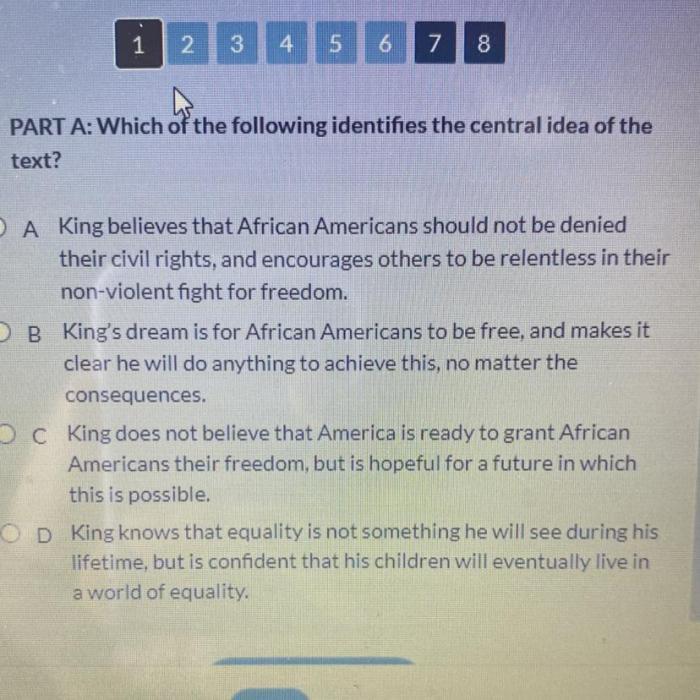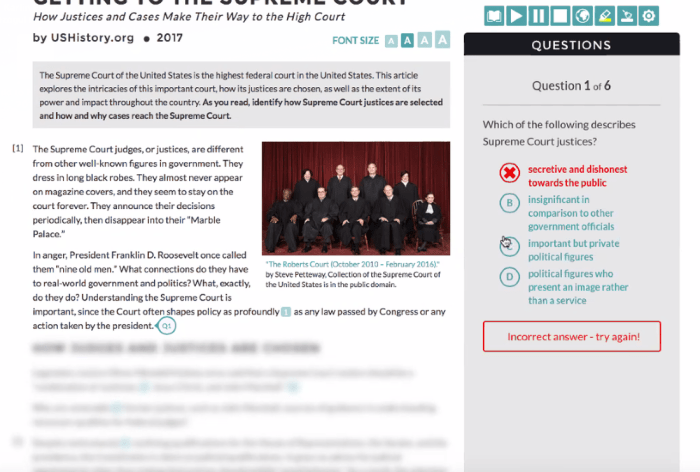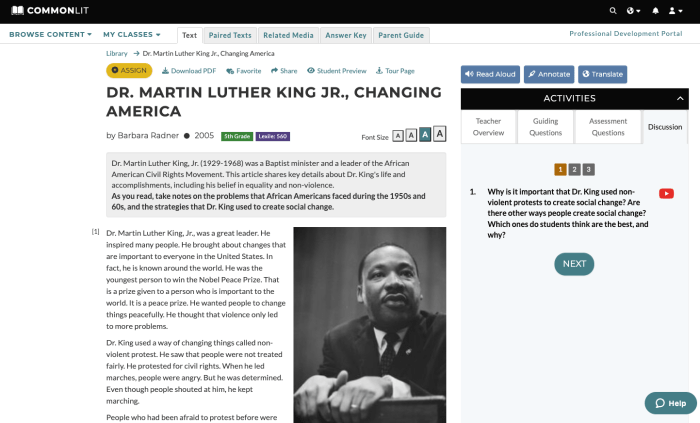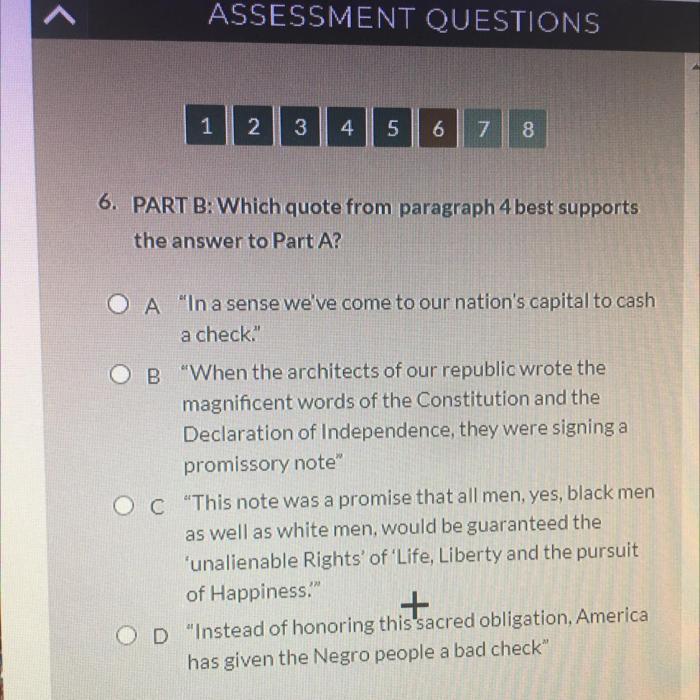I have a dream commonlit – Prepare to embark on an extraordinary journey as we delve into the iconic “I Have a Dream” speech, a masterpiece that ignited the Civil Rights Movement and continues to resonate deeply with audiences today. Dr. Martin Luther King Jr.’s powerful words, delivered with passion and conviction, painted a vivid picture of a future where equality, freedom, and unity prevailed.
Through a meticulous analysis of its rhetorical devices, thematic undertones, and lasting impact, we will explore the profound significance of this oration, which transcended its time to become a timeless symbol of hope and progress.
Historical Context
Dr. Martin Luther King Jr.’s “I Have a Dream” speech, delivered on the steps of the Lincoln Memorial in Washington, D.C., on August 28, 1963, marked a pivotal moment in the Civil Rights Movement.
The speech resonated deeply with the nation, galvanizing support for the movement and inspiring hope for a more just and equitable society. It is widely regarded as one of the most influential speeches in American history.
Social and Political Climate
The United States in the 1960s was a time of great social and political upheaval. The Civil Rights Movement was gaining momentum, but it faced fierce resistance from segregationists and white supremacists.
Racial discrimination was rampant in all aspects of American life, from housing and education to employment and voting rights. African Americans were subjected to violence, intimidation, and other forms of oppression.
Key Events and Figures
Several key events and figures influenced Dr. King’s message in the “I Have a Dream” speech.
- The Montgomery Bus Boycott (1955-1956): A successful campaign led by Dr. King to desegregate buses in Montgomery, Alabama.
- The March on Washington (1963): A massive demonstration that brought together over 200,000 people to demand civil rights legislation.
- President John F. Kennedy: Kennedy supported civil rights and proposed legislation to address the issue, but he was assassinated before it could be passed.
Rhetorical Devices

Martin Luther King Jr.’s “I Have a Dream” speech is a masterpiece of rhetoric, employing a range of devices to captivate and persuade his audience. These devices include metaphors, similes, and repetition, each contributing to the speech’s impact and effectiveness.
Metaphors and Similes
King uses metaphors and similes to create vivid images and draw connections that resonate with his audience. For instance, he compares the struggle for civil rights to a “fierce storm” that “has rocked the foundations of our nation.” This metaphor evokes the intensity and urgency of the fight for equality, while also suggesting that the struggle is a natural force that cannot be ignored.
Similarly, King uses a simile to compare the unity of the civil rights movement to a “beautiful symphony.” This comparison highlights the harmony and cooperation among the diverse groups involved in the movement, while also evoking a sense of beauty and hope.
Repetition
Repetition is another powerful rhetorical device employed by King. He repeats key phrases and ideas throughout the speech, such as “I have a dream” and “let freedom ring.” This repetition creates a sense of rhythm and cadence that draws the audience in and reinforces the main message of the speech.
Parallelism and Cadence
King also uses parallelism and cadence to shape the speech’s message. Parallelism, the use of similar grammatical structures, creates a sense of balance and unity. For example, King says, “We cannot walk alone. We cannot turn back.” This parallelism emphasizes the importance of collective action and the impossibility of retreating from the fight for equality.
Cadence, the rhythm and flow of language, is another important element of King’s speech. He uses short, simple sentences to create a sense of urgency and immediacy. He also employs longer, more lyrical sentences to evoke a sense of hope and inspiration.
Through his masterful use of rhetorical devices, King creates a speech that is both persuasive and inspiring. His words continue to resonate with audiences today, reminding us of the power of language to bring about change.
Thematic Analysis: I Have A Dream Commonlit

Martin Luther King Jr.’s “I Have a Dream” speech is a powerful and moving oration that articulates the central themes of equality, freedom, and unity. These themes are woven throughout the speech, supported by vivid imagery, historical references, and biblical allusions.
Equalityis a core theme that runs through the speech. King argues that all people are created equal and deserve to be treated with dignity and respect. He challenges the racial segregation and discrimination that were prevalent in the United States at the time, calling for an end to the “separate but equal” doctrine.
Freedom, I have a dream commonlit
Closely intertwined with equality is the theme of freedom. King envisions a future where all people are free to live their lives without fear of oppression or violence. He draws inspiration from the Declaration of Independence, reminding his audience that “all men are endowed by their Creator with certain unalienable Rights.”
Unity
King emphasizes the importance of unity in achieving the goals of equality and freedom. He calls for people of all races and backgrounds to come together and work towards a common cause. He believes that by standing together, they can overcome the forces of division and injustice.
The speech’s themes continue to resonate with audiences today, inspiring people to fight for social justice and equality. King’s words remind us that the struggle for freedom and unity is an ongoing one, and that we must continue to work towards a more just and equitable society.
In the resonant words of “I Have a Dream,” Martin Luther King Jr. eloquently captured the essence of hope and equality. His speech is replete with words that evoke a profound sense of purpose and determination. Among these, words with the root “ob” stand out, offering a glimpse into the enduring power of words to inspire and ignite change.
They remind us of the indomitable spirit that fueled the civil rights movement and the unwavering belief in a better future.
Structure and Organization

The speech “I Have a Dream” is a masterpiece of oratory, carefully crafted to deliver a powerful message of hope and equality. Its structure is a testament to Martin Luther King Jr.’s oratorical skills and his ability to captivate and inspire an audience.
Introduction
The introduction sets the stage for the speech, capturing the audience’s attention with a vivid description of the dream of a better future. King uses strong imagery and evocative language to create a sense of urgency and aspiration.
Body
The body of the speech is divided into three main sections, each addressing a different aspect of the dream. King uses transitions and signposts to guide the audience through his arguments, ensuring a smooth and logical flow of ideas.
- The American Dream:King reminds the audience of the promise of equality enshrined in the Declaration of Independence, highlighting the gap between this ideal and the reality faced by African Americans.
- The Struggle for Freedom:King acknowledges the challenges and setbacks faced by the civil rights movement, but he also emphasizes the importance of nonviolent resistance and the power of unity.
- The Vision of the Future:King concludes the body of the speech with a powerful and moving description of his dream of a just and equitable society where all people are treated with dignity and respect.
Conclusion
The conclusion of the speech is a powerful call to action, urging the audience to embrace the dream and work towards its realization. King uses repetition, parallelism, and emotional appeals to leave a lasting impression on the audience.
Impact and Legacy
Martin Luther King Jr.’s “I Have a Dream” speech had an immediate and lasting impact on the Civil Rights Movement and American society. The speech inspired millions of people to join the fight for racial equality, and it helped to change the way Americans thought about race.
In the immediate aftermath of the speech, there was a surge in support for the Civil Rights Movement. The speech helped to galvanize the movement and led to the passage of several landmark civil rights laws, including the Civil Rights Act of 1964 and the Voting Rights Act of 1965.
Long-term Impact
The long-term impact of the speech has been just as profound. The speech has helped to shape American society and has inspired people around the world to fight for justice and equality. The speech’s message of hope and unity continues to resonate today, and it remains a powerful reminder of the work that still needs to be done to achieve true racial equality.
Inspiration and Motivation
The “I Have a Dream” speech continues to inspire and motivate people today. The speech’s message of hope and unity is a powerful reminder that anything is possible if we work together. The speech has inspired countless people to get involved in the fight for social justice, and it continues to be a source of hope and inspiration for people around the world.
Cultural Significance

The “I Have a Dream” speech has become an iconic symbol of hope and progress for people around the world. It has inspired countless individuals and movements, and its message of equality and justice continues to resonate today.The speech has been referenced and reinterpreted in popular culture in countless ways.
It has been quoted in movies, TV shows, and songs. It has been used as a rallying cry for civil rights protests and other social justice movements. And it has been taught in schools and universities around the world.
The Speech as a Symbol of Hope
The “I Have a Dream” speech is a powerful reminder that even in the face of adversity, hope can prevail. King’s words have inspired people to believe that a better future is possible, and they have given people the courage to fight for their dreams.
The Speech as a Call to Action
The “I Have a Dream” speech is also a call to action. King urged his listeners to work together to create a more just and equitable society. He challenged them to be agents of change, and he inspired them to believe that they could make a difference.
The Speech’s Enduring Legacy
The “I Have a Dream” speech is a timeless masterpiece that continues to inspire and motivate people around the world. It is a reminder that the fight for justice is never over, and it is a call to action for all of us to work together to create a better future for all.
FAQ
What was the main purpose of Dr. King’s “I Have a Dream” speech?
To galvanize support for the Civil Rights Movement and advocate for an end to racial discrimination and segregation.
How did Dr. King’s use of rhetorical devices enhance the speech’s impact?
Through the use of metaphors, similes, repetition, parallelism, and cadence, Dr. King created a powerful and emotionally resonant message that connected with audiences on a visceral level.
What is the lasting legacy of the “I Have a Dream” speech?
The speech continues to inspire and motivate people around the world, reminding them of the importance of fighting for justice, equality, and freedom.